Antitumor agent-81
Modify Date: 2023-02-08 17:50:38

Antitumor agent-81 structure
|
Common Name | Antitumor agent-81 | ||
|---|---|---|---|---|
| CAS Number | 2765180-17-2 | Molecular Weight | 393.40 | |
| Density | N/A | Boiling Point | N/A | |
| Molecular Formula | C19H19N7O3 | Melting Point | N/A | |
| MSDS | N/A | Flash Point | N/A | |
Use of Antitumor agent-81Antitumor agent-81 (compound 5a) is a low cytotoxic P62-RNF168 agonist that promotes the interaction of P62 with RNF168. Antitumor agent-81 induces a decrease in RNF168-mediated H2A ubiquitination and impairs homologous recombination-mediated DNA repair. Antitumor agent-81 also inhibits mice xenograft tumor growth in a dose-dependent manner[1]. |
| Name | Antitumor agent-81 |
|---|
| Description | Antitumor agent-81 (compound 5a) is a low cytotoxic P62-RNF168 agonist that promotes the interaction of P62 with RNF168. Antitumor agent-81 induces a decrease in RNF168-mediated H2A ubiquitination and impairs homologous recombination-mediated DNA repair. Antitumor agent-81 also inhibits mice xenograft tumor growth in a dose-dependent manner[1]. |
|---|---|
| Related Catalog | |
| In Vitro | Antitumor agent-81 (0-20 µM; 72 h) exhibits antiproliferative activity in cells of the most common cancer types[1]. Antitumor agent-81 (1, 2, 5 µM; 24 h) compromises HR (homologous recombination)-mediated DSB repair in HCT-116 cells[1]. Antitumor agent-81 tethers the interaction between P62 and RNF168 in HCT-116 cells[1]. Antitumor agent-81 inhibits the catalytic activity of RNF168 and RNF168 E3 ligase activity in HCT-116 cells[1]. Cell Proliferation Assay[1] Cell Line: A549, HCT-116, A375, HeLa, HepG2, MCF-7, MDA-MB-231, MGC-803, U2OS and MCF-10A cells Concentration: 0-20 µM Incubation Time: 72 h Result: Inhibited A549, HCT-116, A375, HeLa, HepG2, MCF-7, MDA-MB-231, MGC-803, U2OS and MCF-10A cells, with IC50 values of 1.18, 0.36, 1.93, 2.48, 19.61, 2.79, 1.17, 1.88, 3.64 and 6.98, respectively. Cell Cycle Analysis[1] Cell Line: HCT-116 cells Concentration: 1, 2, 5 µM Incubation Time: 24 h Result: Induced a G2/M arrest but no significant accumulation of sub-G1 phase. Compromised both HR(homologous recombination)- and NHEJ (non-homologous end joining)- mediated DSB repair in a dose-dependent manner, but HR was the more severely impacted process. |
| In Vivo | Antitumor agent-81 (5, 10 mg/kg; i.p.; single every 3 days for 22 days) suppresses tumor volumes in a dose-dependent manner in mice[1]. 1.19Pharmacokinetic Parameters of Antitumor agent-81 in Female BALB/c nude mice[1]. Dose T1/2 (h) Cmax (ng/mL) AUC0-t (hng/mL) CL ((mL/h)/kg) IP (5 mg/kg) 16.17 26.10 215.69 19647.83 IP (10 mg/kg) 31.00 39.87 408.18 16554.30 IP (20 mg/kg) 22.10 52.23 1003.58 14669.81 Animal Model: Female BALB/c nude mice (xenograft tumor model)[1]. Dosage: 5, 10 mg/kg Administration: Intraperitoneal injection; single every 3 days for 22 days Result: Suppressed tumor growth by promoting apoptosis in xenografted tumorigenesis. Animal Model: Female BALB/c nude mice[1]. Dosage: 5, 10, 20 mg/kg Administration: Intraperitoneal injection; single Result: Exhibited plasma concentration peaked 1 h after administration. Showed a relatively high maximum concentration (Cmax= 52.23 ng/mL) and exposure (AUC0-t= 1003.58 h•ng/mL) at a dose of 20 mg/kg. |
| Molecular Formula | C19H19N7O3 |
|---|---|
| Molecular Weight | 393.40 |